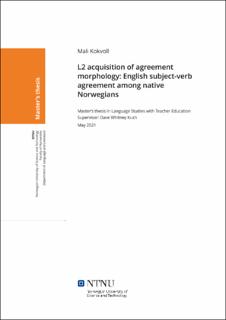| dc.description.abstract | Norwegian learners of English struggle with subject-verb agreement, often producing errors well into advanced stages. An Acceptability Judgement Task (AJT) was conducted in order to examine Norwegian speakers (N=28) intuitions about English subject-verb agreement constructions and how different factors affect their judgments. The design manipulated three factors: (1) Grammaticality, (2) Subject Number, and (3) Verb type, which led to a 2x2x2 factorial design with eight conditions. The results from the AJT were compared against the predictions of three different hypotheses that propose different explanations as to why L2 learners struggle with acquisition of functional morphology. The hypotheses were Representational Deficit Hypothesis, Missing Surface Inflection Hypothesis and Feature Reassembly Hypothesis.
The results revealed three main effects: (1) participants’ average accuracy was marginally higher in grammatical conditions than in ungrammatical conditions, (2) error rates were higher overall when the subject NP was plural and (3) items with auxiliary verbs were rated more accurately on average than items with main verbs. In addition to this, two interaction effects were found showing that participants were less accurate with plural agreement when the verb was a main verb than auxiliary, and that errors with auxiliary verbs were rejected more consistently than errors with main verbs. Finally, the results also showed an interaction between self-reported hours of exposure to English and accuracy: participants’ accuracy increased in line with how much English Media exposure they had per week.
The findings confirm that English subject-verb agreement is, in general, problematic for (advanced) Norwegian learners. The overall pattern of errors is not predicted by any of the hypotheses considered in isolation. | |
